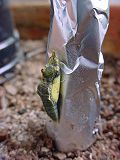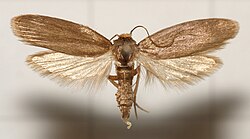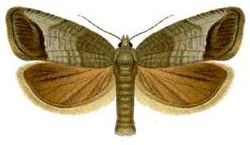Difference between revisions of "AY Honors/Moths & Butterflies/Answer Key"
| Line 57: | Line 57: | ||
[[Image:Cydia pomonella (Falter).jpg|thumb|200px|Colding moth]] | [[Image:Cydia pomonella (Falter).jpg|thumb|200px|Colding moth]] | ||
Coddling moths are known as an agricultural pest, their larva being the common apple worm or maggot. It is native to Europe and was introduced to North America, where it has become one of the regular pests of apple orchards. It is found almost worldwide. It also attacks pears, walnuts, and other tree fruits. This larva is the famous "worm in the apple" of cartoon and vernacular fame. | Coddling moths are known as an agricultural pest, their larva being the common apple worm or maggot. It is native to Europe and was introduced to North America, where it has become one of the regular pests of apple orchards. It is found almost worldwide. It also attacks pears, walnuts, and other tree fruits. This larva is the famous "worm in the apple" of cartoon and vernacular fame. | ||
| + | {{clear}} | ||
===House Moths=== | ===House Moths=== | ||
Revision as of 02:26, 29 June 2008
Template:Honor header Template:AY Master Template:AY Master
1. What is the distinction between moths and butterflies?
The division of Lepidopterans into moths and butterflies is a popular taxonomy, not a scientific one. The distinctions listed here are not absolute. There are many butterflies with some of the characteristics of moths and many moths with some of the characteristics of butterflies.
Antennae
The most obvious difference is in the feelers, or antennae. Most butterflies have thin slender filamentous antennae which are club shaped at the end. Moths, on the other hand, often have comb-like or feathery antennae, or filamentous and unclubbed.
Pupae
Most moth caterpillars spin a cocoon made of silk within which they metamorphose into the pupal stage. Most butterflies on the other hand form an exposed pupa which is also termed as a chrysalis.
Coloration of the wings
Most butterflies have bright colours on their wings. Nocturnal moths on the other hand are usually plain brown, grey, white or black and often with obscuring patterns of zigzags or swirls which help camouflage them as they rest during the day. However many day-flying moths are brightly-colored, particularly if they are toxic. A few butterflies are also plain-colored, like the Cabbage White butterfly.
Time of activity
Most moths are nocturnal while most butterflies are diurnal. There are however exceptions, including the diurnal Gypsy moth and the spectacular "Uraniidae" or Sunset moths.
Resting posture
Moths usually rest with their wings spread out to their sides. Butterflies frequently fold their wings above their backs when they are perched although they will occasionally "bask" with their wings spread for short periods.
2. Define the following terms: antennae, cocoon, pupa, larva, chrysalis.
- Antennae
- Antennae are paired appendages connected to the front-most segments of an insect. Antennae are jointed, at least at the base, and generally extend forward from the head. They are sensory organs, although the exact nature of what they sense and how they sense it is not the same in all groups, nor always clear. Functions may variously include sensing touch, air motion, heat, vibration (sound), and especially smell or taste.
- Cocoon
- A cocoon is a casing spun of silk by many moth caterpillars and numerous other insect larvae as a protective covering for the pupa.
- Pupa
- A pupa is the life stage of some insects undergoing transformation.
- Larva
- A larva is a juvenile form of animal with indirect development, undergoing metamorphosis (for example, insects or amphibians). The larva can look completely different from the adult form, for example, a caterpillar differs from a butterfly. Larvae often have special (larval) organs which do not occur in the adult form.
- Chrysalis
- A chrysalis or nympha is the pupal stage of butterflies. Because chrysalids are often showy and are formed in the open they are the most familiar examples of pupae. Most chrysalids are attached to a surface by a Velcro-like arrangement of a silken pad spun by the caterpillar and a set of hooks at the tip of the pupal abdomen.
3. Be able to identify three moths and/or butterflies by their cocoons.
4. What causes colored powder to come off on your hands when you handle the wings of a butterfly or moth? Examine the powder of a butterfly or moth with a magnifying lens and describe your findings.
This powder is made from tiny scales which cover the butterfly's wings. These scales give the wings their color, as the membrane beneath the scales is nearly transparent. The scales detach when abraded by a finger, much as the skin on a person's knee is abraded when it contacts a sidewalk.
5. Name three harmful tree moths and one harmful house moth and tell during what stage of their lives they each do their damage.
Tree Moths
Gypsy Moth
Tent caterpillar
Lesser wax moth
Wax moths were first seen in North America in 1806. People believe they came over with honeybees from Europe. The lesser wax moth is very common all over the world, except the colder regions. The larvae are the only ones that eat, the adults will not eat.
Their diet typically consists of honey, beeswax, stored pollen, bee shell casings, and, in some cases, bee brood. While tunneling through honeycombs attaining food, these moths are also protecting themselves from their main enemy, the honeybee.
Codling moth
Coddling moths are known as an agricultural pest, their larva being the common apple worm or maggot. It is native to Europe and was introduced to North America, where it has become one of the regular pests of apple orchards. It is found almost worldwide. It also attacks pears, walnuts, and other tree fruits. This larva is the famous "worm in the apple" of cartoon and vernacular fame.
House Moths
6. What famous butterfly follows the birds southward every winter and comes northward in the spring ?
Monarch butterflies are especially noted for their lengthy annual migration. They make massive southward migrations starting in August until the first frost. A northward migration takes place in the spring. Female Monarchs deposit eggs for the next generation during these migrations. By the end of October, they reach their overwintering grounds. The length of these journeys exceeds the normal lifespan of most Monarchs, which is less than two months for butterflies born in early summer. The last generation of the summer enters into a non-reproductive phase known as diapause and may live up to 7 months. During diapause, butterflies fly to one of many overwintering sites. The generation that overwinters generally does not reproduce until it leaves the overwintering site sometime in February and March. It is thought that the overwinter population may reach as far north as Texas and Oklahoma during the spring migration. It is the second, third and fourth generations that return to their northern locations in the United States and Canada in the spring. How the species manages to return to the same overwintering spots over a gap of several generations is still a subject of research; the flight patterns appear to be inherited, based on a combination of circadian rhythm and the position of the sun in the sky.






